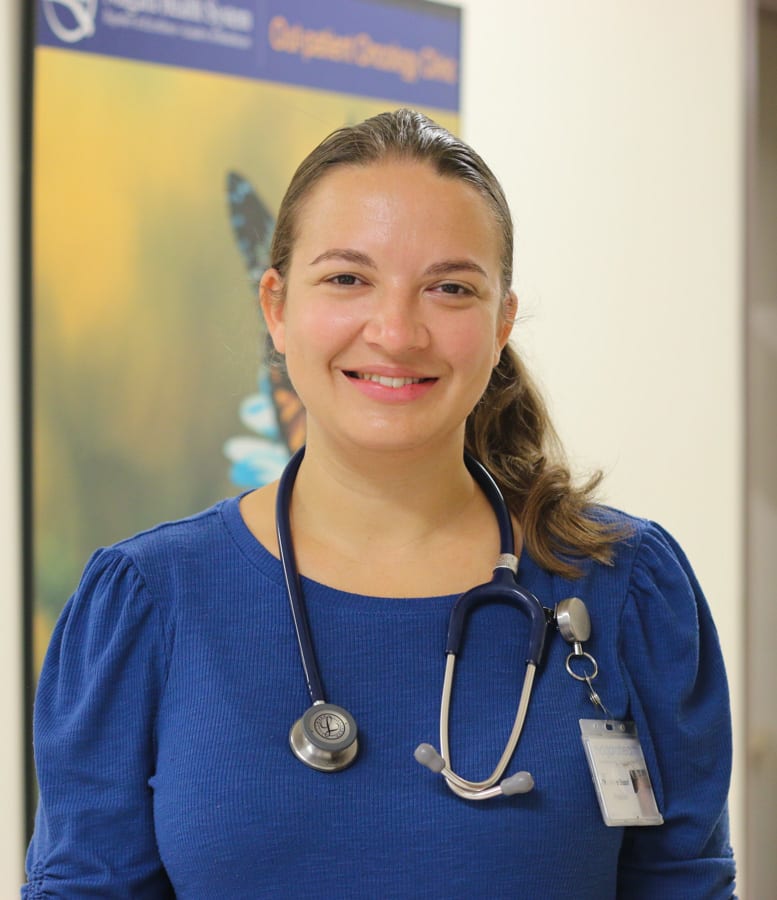
If you have a 50th birthday coming up, you can expect to receive a letter from the Ontario Breast Screening Program (OBSP) to mark the milestone.
In it, recipients will be encouraged to book a mammogram at their closest OBSP screening centre.
The thought of going for a medical test that can detect breast cancer may seem downright scary to some, however, and they may hesitate booking their appointment. But Dr. Jennifer Bisson, a medical oncologist who specializes in breast and women’s health at the Walker Family Cancer Centre, urges anyone due for a mammogram to schedule one as soon as possible.
“Fifty is the sweet spot for when the risk of breast cancer goes up and it becomes the age for screening to start,” Dr. Bisson says.
The good news is, if you’re an eligible woman, Two-Spirit, trans and non-binary person, starting regular screening at 50 and going every two years until the age of 74 increases the chances of early detection – sometimes even before a lump can be felt – and successful treatment of pre-cancer and cancer.
Dr. Bisson offers up a few ways to put your mind at ease about your appointment and make your mammogram go more smoothly, whether it’s your first, your fifth or you get a callback after a test.
What happens during a mammogram?
A mammogram is a type of X-ray picture of the breast. While standing in front of a mammogram machine, a technologist places a patient’s breast on a plate. Another plate is lowered onto the breast, firmly pressing down from above to flatten the breast and hold it in place while images are being taken.
This may feel uncomfortable or painful but the entire process lasts only a few moments. However, images may need to be redone during the same test.
Technologists can’t discuss with patients what they see in the images they capture. Results will be shared by mail from the OBSP or by primary care providers.
“Fifty is the sweet spot for when the risk of breast cancer goes up and it becomes the age for screening to start."

Dr. Jennifer Bisson
Timing is everything
Pre-menopausal people going for their first mammograms may experience tender breasts in the week before or after their period, which may make the process of a mammogram more uncomfortable.
“If you can choose your appointment time, schedule your mammogram away from your period so your breasts will be less tender,” Dr. Bisson says.
Cut the caffeine
Consuming caffeine in the week leading up to a mammogram can also increase the risk of tender breasts and a painful mammogram. Dr. Bisson suggests minimizing caffeine, including coffee, tea, energy drinks and dark chocolate, as much as possible prior to an appointment. However, consuming caffeine won’t affect test results.
Dress for the occasion
Patients will be required to remove their top and bra during a mammogram. Dr. Bisson suggests wearing a two-piece outfit, such as a shirt and pants, so only the top needs to be removed for your appointment. Avoid dresses or one-piece outfits that need to be removed entirely. Wear a bra that is easy to put on and take off as well.
Keep it simple
Avoid applying deodorant, including under the arms, lotion or perfume in the chest or breast areas on the day of your appointment.
“Shower and pat dry, and don’t apply anything else because it can affect the quality of the imaging,” Dr. Bisson says.
Use pain relief
Most people don’t feel any pain or discomfort after their procedure. For those who do, rest assured. It will typically be short-lived. However, Dr. Bisson notes there are no issues with taking a mild anti-inflammatory, such as Advil, before or after a mammogram to help with pain relief. Hot and cool compresses can also be used.
“The discomfort goes away fairly quickly, or within a day or two, and those supportive measures can help in the meantime,” she says.
What does it mean if I get a callback after a mammogram?
It’s natural to be concerned but Dr. Bisson assures a callback doesn’t necessarily mean bad news.
For every 200 mammograms, an average of 18 people are called back for further testing, and of those, only one will receive a cancer diagnosis.
Callbacks can happen because of issues with the mammogram images. Tissue can overlap, creating shadows, which need to be double-checked. This is usually done by additional mammogram views and/or ultrasound. If the findings are benign, a patient goes back to their regular screening schedule and nothing further is needed. OBSP will send a reminder in two years to book another mammogram, although Dr. Bisson urges people to stay on top of their own testing schedule.
Follow-up imaging may determine an irregularity in mammogram images is actually a cyst. Breast cysts are common in younger, pre-menopausal patients. In addition, breast tissue is usually denser in younger patients, making callbacks more likely to happen for this group.
A patient needing further testing will likely receive a callback within one to four weeks of their original mammogram, and their primary care provider will be notified. Results are usually delivered within a week after a callback and then next steps are determined.
“It’s natural to feel anxious about a callback but you can go for more images to ensure there’s no concern,” Dr. Bisson says. “A callback, more often than not, turns out to be nothing worry about.”

